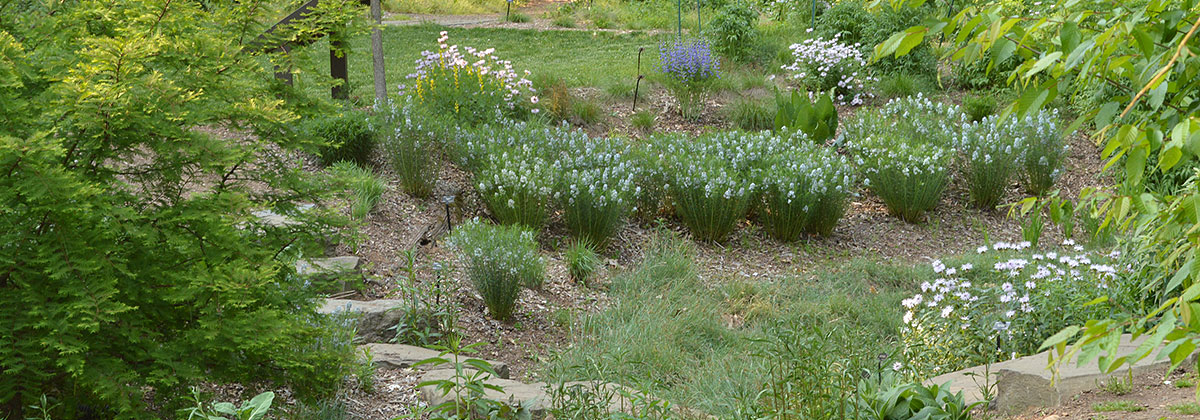
In our pollinator garden, we focus on planting appropriate and diverse native plants, providing water, and using herbicides carefully (if at all) to attract, support, and protect native pollinators. Native plants have naturally adapted to grow well in the areas where they are found and often have a specialized relationship with the pollinators that are also native to that area. Although some plants rely on wind or water, almost 90% of plant species require the help of pollinators, such as bees, butterflies, moths, flies, beetles, hummingbirds, and bats, to help set seed and produce fruit. In return for their efforts, pollinators receive food, warmth, migratory sites, and shelter for mating, nesting, laying eggs, and overwintering. Unfortunately, improper use of pesticides, destruction of habitats, and even the invasion of non-native plant species that take the place of native vegetation can dangerously impact our native pollinators.
Some of the native plants in our Pollinator Garden include:
- Bee Balm (Monarda species)
- Blue Star (Amsonia hubrichtii)
- Blue Wild Indigo (Baptisia australis)
- Blueberry (Vaccinium spp.)
- Butterfly Weed (Asclepias tuberosa)
- Compass Plant (Silphium lanciniatum)
- Field Pussytoes (Antennaria neglecta)
- Fothergilla (Fothergilla gardenia)
- Ironweed (Vernonia glauca)
- Lanceleaf Loosestrife (Lysimachia lanceolata)
- Mountain Mint (Pycnanthemum muticum)
- Pinnate Prairie Coneflower (Ratibida pinnata)
- Prairie Dock (Silphium terebinthinaceum)
- Prairie Dropseed (Sporobolus heterolepis)
- Rattlesnake Master (Eryngium yuccifolium)
- Sedges (Carex spp.)
- Shaggy Blazing Star (Liatris pilosa)
- Sumac (Rhus copallina)
- Sweet Pepper-bush (Clethra alnifolia)
- Thoroughwort (Eupatorium hyssopifolium)
- Viburnum (Viburnum dentatum)
- Zigzag Goldenrod (Solidago flexicaulis)
Depending on the structure of a plant’s flowers, pollen can be spread by wind, water, and frequently by insects such as bees, butterflies, beetles, and flies that collect and feed on pollen and nectar or even mate on the flowers. Pollen grains that stick to their legs, wings, and bodies are carried along and brushed onto the stigmas of other flowers they visit, resulting in production of seeds and fruit. Hummingbirds perform this same task, while sipping from flower to flower. This happens with many of the vegetables, annuals, and flowering plants in our gardens and landscape.
Many animal and insect pollinators are now in decline, including the honey bee (Apis mellifera) and many other beneficial bees. But honey bees (which are actually native to Europe) are only one of more than 20,000 bee species in the world, 4,000 of which are native to the United States! Different species of both bees and wasps may live in the ground, burrow into wood, or build paper nests or even “mud” tubes. Many moths, butterflies, and beetles actually feed and live most of their life cycles on specific plants. While butterflies often form chrysalides directly on their host plant, moth cocoons are often formed on the undersides of leaves or twigs, in bark crevices, or even in leaf litter on the ground. If we do our part to encourage all types of beneficial pollinating insects, by providing appropriate habitats, they will reward us by making our habitats more productive and beautiful, too.
Some of the common types of native pollinators you are likely to see in this area include:
Butterflies
- American Lady Butterfly (Vanessa virginiensis)
- Baltimore Checkerspot Butterfly (Euphydryas phaeton)
- Black Swallowtail Butterfly (Papilio polyxenes)
- Cabbage White Butterfly (Pieris rapae)
- Clouded Sulphur Butterfly (Colias philodice)
- Common Buckeye Butterfly (Junonia coeni)
- Eastern Tailed-blue Butterfly (Cupido comyntas)
- Eastern Tiger Swallowtail Butterfly (Papilio glaucus)
- Fiery Skipper Butterfly (Hylephila phyleus)
- Monarch Butterfly (Danaus plexippus)
- Mourning Cloak Butterfly (Nymphalis antiopa)
- Orange Sulphur Butterfly (Colias eurytheme)
- Painted Lady Butterfly (Vanessa cardui)
- Question Mark Butterfly (Polygonia interrogationis)
- Red Admiral Butterfly (Vanessa atalanta)
- Silver-spotted Skipper Butterfly (Epargyreus clarus)
- Spicebush Swallowtail Butterfly (Papilio troilus)
- Wild Indigo Duskywing Butterfly (Erynnis baptisiae)
Moths
- Geometer Moths, Inchworms (Geometridae family)
- Hummingbird Moth (Hemaris diffinis)
- Owlet Moths (Noctuidae family)
- Underwing Moths (Catocala species)
Bees
- Bumblebees (Bombus species)
- Carpenter Bees (Xylocopa species)
- Leafcutter Bees (Megachile species)
- Miner Bee (Andrena cornelli)
- Squash Bees (Peponapis species)
- Sweat Bees (Agapostemon, Halictus, and Lasioglossum species)
- Wandering Cuckoo Bees (Nomada species)
Wasps
- Great Black Wasp (Sphex pensylvanicus)
- Pollen Wasps (Pseudomasaris species)
- Scoliid Wasp (Scolia dubia)
Beetles
- Blister Beetles (Meloidae family)
- Checkered Beetles (Cleridae family)
- Locust Borer (Megacyllene robiniea)
- Sap Beetles (Nitidulidae family)
- Soft-wing Flower Beetles (Melyridae family)
- Soldier Beetles (Cantheridae family)
- Tumbling Flower Beetles (Mordellidae family)
Other
- Hoverflies, Flower Flies (Syrphidae family)
- Ruby-Throated Hummingbird (Archilochus colubris)







